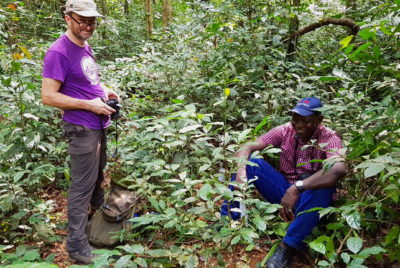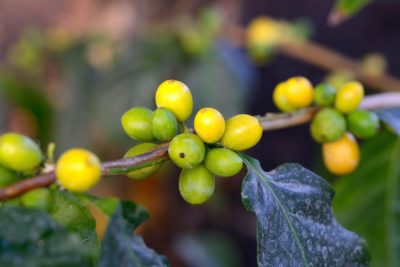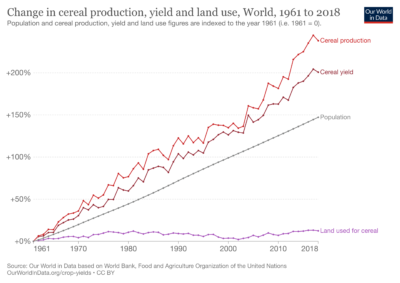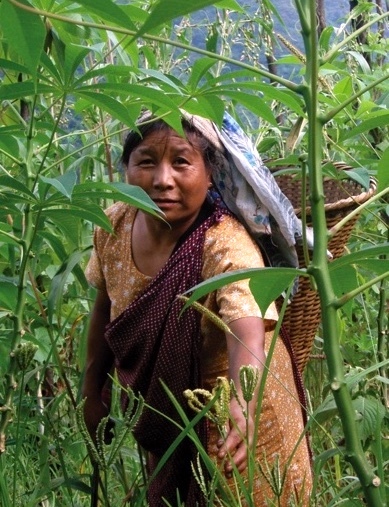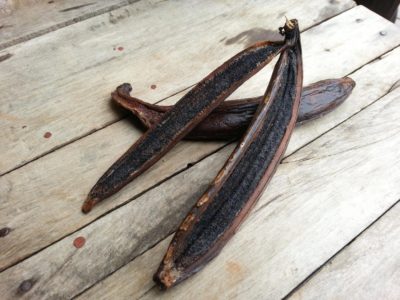In August 2020, inside the cupping room of a London roastery, a team of botanists and baristas gathered to taste a coffee species that most believed had been lost forever. It was an important moment. Coffee experts had spent years searching in West Africa for the few remaining trees of this species, even issuing “wanted posters” to farmers asking if they had seen it.
The coffee, named stenophylla, had last been recorded in Sierra Leone in the 1950s, but civil war and widespread deforestation had pushed it to the brink of extinction. In 2018, with the help of the Royal Botanic Gardens in Kew, a small cluster of stenophylla trees were found, which two years later produced just nine grams of beans. The first sips provided hope. “It’s fragrant, fruity, and sweet,” said Aaron Davis, Kew’s senior research leader for Crops and Global Change. “Stenophylla is a coffee with real potential.”
Since then, seeds have been collected from the surviving trees in Sierra Leone, and 5,000 seedlings are being grown in nurseries. This is significant for us all, not just coffee aficionados. That’s because saving diverse foods, whether plant species or animal breeds, will give us the options we’ll need in an increasingly uncertain future.
Since the Second World War, we’ve created a highly productive but incredibly fragile food system.
The case of stenophylla is just one of almost 40 such stories I discovered while researching my book, Eating to Extinction: The World’s Rarest Foods and Why We Need to Save Them. In it, I argue that we’re at a pivotal moment in our food history and in a race against time to save diversity. Stenophylla helps illustrates the point. Although there are 130 coffee species so far identified, the world depends on just two, arabica and robusta. Both of these are vulnerable to climate change. Arabica is best suited to temperatures around 19 degrees C (66 degrees F); fluctuations in this can reduce productivity and encourage coffee leaf rust, a devastating fungal disease. Robusta, an inferior-tasting species, fares slightly better, growing at low elevations across much of wet-tropical Africa, but it needs consistent moisture throughout the year.
Stenophylla, on the other hand, can cope with higher temperatures and possesses greater tolerance to drought, as well as being a great-tasting coffee, one that Victorian botanists even described as “superior” to arabica. If arabica starts to fail, as it did catastrophically across Southern Asia in the 19th century and again in Central America in 2014, millions of coffee farmers will be affected. History will repeat itself: Coffee supply chains will be put at risk, family incomes will fall, and regional economies will be devastated, triggering waves of migration. We need to keep our options open.
Since the Second World War, we’ve created a highly productive but incredibly fragile food system. Like an investor with a stock portfolio of just a few holdings, we removed an important safety net for our food supplies: diversity. By narrowing the genetic base of the global food system and focusing on highly productive but increasingly uniform crops and animal breeds, we have increased our vulnerability to the impacts of climate change: extremes of temperature, more virulent outbreaks of disease, droughts, and erratic rainfall. Diversity gives us options and provides resilience.
Left: Researchers Aaron Davis of Kew Gardens (left) and John Brima of the Sierra Leone Forestry Department with a stenophylla coffee plant. Right: Stenophylla beans up close.
RBG Kew; Klaus Steinkamp / Alamy
In less than a century, most of the world has become dependent on a small number of crops for its sustenance. Since the dawn of agriculture (roughly 12,000 years ago) humans have domesticated around 6,000 plant species for food, but now just nine provide the bulk of our calories, and four of these — wheat, corn, rice, and soy — supply roughly two-thirds of that intake. The bottleneck doesn’t end there. Despite the huge genetic variation found within these crops, just a few varieties of each are selected to be grown in vast monocultures.
In Victorian Britain it was possible for people to eat a different apple every day for more than four years and never have the same one twice. Today, supermarkets typically offer four or five varieties, all extremely similar in levels of sweetness and texture. In the United States, at the beginning of the 20th century, farmers grew thousands of different locally adapted varieties of corn. By the early 1970s a small number of hybrids dominated, and all were later found to be susceptible to a disease called leaf blight. Perhaps most famously of all, although there are more than 1,500 different varieties of banana, global trade is dominated by just one, the Cavendish, a cloned fruit grown in vast monocultures and increasingly at risk from a devastating fungal disease, TR4. Where nature creates diversity, the food system crushes it.
The decline in the diversity of our food, and the fact that so many foods have become endangered, didn’t happen by accident; it is an entirely human-made problem. The biggest loss of crop diversity came in the decades that followed the Second World War when, in an attempt to save millions from starvation, crop scientists found ways to produce grains such as rice and wheat on a phenomenal scale. To grow the extra food the world desperately needed, thousands of traditional varieties were replaced by a small number of new, super-productive ones. The strategy that ensured this — more agrochemicals, more irrigation, plus new genetics — came to be known as the “Green Revolution.”
Farmers have grown more cereals on roughly the same amount of land since the Green Revolution.
Our World In Data
Because of it, grain production tripled, and between 1970 and 2020 the human population more than doubled. But the danger of creating more uniform crops is that they become vulnerable to catastrophes. A global food system that depends on just a narrow selection of plants is at greater risk of succumbing to diseases, pests, and climate extremes.
Although the Green Revolution was based on ingenious science, it attempted to oversimplify nature, and this is starting to backfire on us. In creating fields of identical wheat, we abandoned thousands of highly adapted and resilient varieties. Far too often their valuable traits were lost. We’re starting to see our mistake — there was wisdom in what went before. And there are encouraging developments: Wherever you look in the world, you can find people working to save an endangered food and preserving the diversity we all need.
In India, farmers are looking once again to landrace, or native, varieties of millet. Millet is a nutrient-packed and diverse cereal that sustained generations of people in India. But British colonizers, unaware of millet’s unique nutritional qualities and resilience, replaced it with varieties of bread wheat and cash crops such as indigo. Those millets that survived were mostly relegated to animal feed. The decline of millet continued after Indian independence and was intensified by the Green Revolution as rice cultivation expanded. As a result, the last harvests of many millet varieties were recorded in the early 1970s.
“Despite its many achievements, the Green Revolution locked us into an unsustainable system,” says an expert.
Among these was a millet grown by the Khasi people of Meghalaya, in northeast India. Their millet was called Raishan, an ivory-colored grain cooked into soups and baked into biscuits and flatbreads. Like millions of Indians, the Khasi became dependent on the state-run Public Distribution System, which today provides $2.25 billion worth of subsidized food — mostly rice, wheat, and sugar — to India’s poorest 160 million households. Millet — labor-intensive to harvest and to mill — was the first food they stopped growing themselves. Then, in 2008, in India and in the rest of rice-growing Asia, a huge supply crisis caused by a sequence of bad harvests, disease outbreaks, and low grain reserves hit food systems. Governments responded by banning rice exports, which in turn triggered panic and a massive price spike. In many of the Khasi villages of Meghalaya, one response was to bring back lost millets.
In 2017, as part of the research for my book, I visited one of these villages, Nongtraw, which is located at the bottom of a valley so steep it can only be reached by climbing down the 2,500 steps cut into the landscape. In one of the bamboo huts, I watched as a milling machine did in ten seconds what used to take an hour with a pestle and mortar. The Khasi villagers of Nongtraw now look like pioneers, as millet is being seen as one of the solutions to many of India’s food problems. With a diet that became heavily dependent on modern varieties of white rice and refined wheat flour, India suffers from a triple burden of malnutrition: One in nine people is undernourished; one in eight adults is obese; and one in five people is affected by some form of micronutrient deficiency.
Indian farmer Kong Bibiana in her millet field in the village of Nongtraw.
North East Slow Food & Agrobiodiversity Society
Another problem facing India is water — or the lack of it. Half of India’s rice crop is irrigated by underground water supplies, and Indian aquifers are emptying at a faster rate than they are being replenished. When a team of scientists — including water experts, plant breeders, and nutritionists — calculated what would happen if large areas of water-intensive rice cultivation were replaced with millets and sorghum, they found benefits on every level: more dietary nutrients, lower greenhouse gas emissions, greater resilience to climate change, reduced water and energy use. All of this could be achieved without losing a single calorie or expanding croplands, they concluded.
“Despite its many achievements, the Green Revolution locked us into an unsustainable system,” says lead researcher and food systems expert Kyle Davis of the University of Delaware, “and without crop diversity we won’t break out.” This makes endangered varieties of millet, such as Raishan, look like a food of the future, not one to be lost to the past.
In 2017, an international team of crop scientists modeled the impact of rising temperatures on yields of major crops. Their research showed that “each degree-Celsius increase in global mean temperature would, on average, reduce global yields of wheat by 6 percent, rice by 3.2 percent, maize by 7.4 percent, and soybean by 3.1 percent.” There are varieties of all of these crops, lost to farmers fields in the 20th century but stored away in seed banks, that, just like Raishan millet, possess traits that will give us greater resilience for the future.
And building resilience in food systems in one part of the world can benefit others, as is the case with efforts to preserve an endangered type of wild vanilla found in central Brazil, important to a community known as the Kalunga.
Descendants of escaped slaves, the Kalunga created a network of villages in the Cerrado, the immense plateau of savannah, grasslands, and tropical forest that takes up nearly a quarter of Brazil’s land mass. Here, as well as growing rice, beans, and sesame, the Kalunga use wild plants, among them an endangered type of wild vanilla with which they brew infusions and flavor food. Its pods are larger than all other known types of vanilla — it’s more the size of a banana than a bean — and its taste is more intense. The pods are harvested in spring, mostly from along the rivers that wind through the Cerrado’s forests, where it grows among moriche palms. For the Kalunga, going in search of the pods is like mushroom foraging; everyone has a secret patch. But even with this knowledge, finding a pod isn’t guaranteed because vanilla-loving monkeys provide fierce competition.
Neither the Kalunga nor the monkeys are the cause of the vanilla’s endangered status, however; newly arrived farming businesses and mining companies are clearing or degrading the land and driving the loss of biodiversity.
The Kalunga can help preserve the Cerrado’s remaining biodiversity, but only if they are provided with economic opportunities to do so. This is where the wild vanilla comes in. “By protecting the Kalunga communities, we can protect the Cerrado,” says Alex Atala, one of Brazil’s most high-profile chefs. “The wild vanilla provides an economic opportunity. The plant can give the Kalunga settlements a future, and the communities can help keep a check on the expansion of soy farming.”
Our broken food system needs to be rebuilt with diversity at its core.
Projects have been set up to help the Kalunga hand-pollinate the vanilla plants (to increase yields) and to improve their processing techniques. “One family can make $50 a day,” Atala says, “more money than welfare payments or the wages paid by the illegal mines.” Saving the Cerrado isn’t just about protecting the rivers and the forests — its people need to be protected as well, he believes. “They are defenders of biodiversity. Why? Because they depend on it.”
But then again, we all do. Although it’s less well known than the neighboring Amazon, the Cerrado is one of the richest centers of biodiversity in the world. As one of the world’s major carbon sinks, its preservation is vital in the fight against the climate crisis.
Transformation of the food system and the need to rethink farming appeared to be low down on the agenda at COP26, the UN Climate Change Conference held in Glasgow last November. Not one of the 10 themed days was dedicated to agriculture or our eating habits. But around the world there are grassroots food heroes and Indigenous activists taking it upon themselves to conserve diversity, save endangered foods, and keep alive knowledge and skills, some for reasons of identity and culture, others to build resilience and increase self-sufficiency. Our broken food system needs to be rebuilt with diversity at its core. This isn’t a call to return to a mythical or halcyon past, but a plea to value and celebrate the ingenuity and legacy of generations of farmers and food producers. It’s up to us to continue their legacy.

